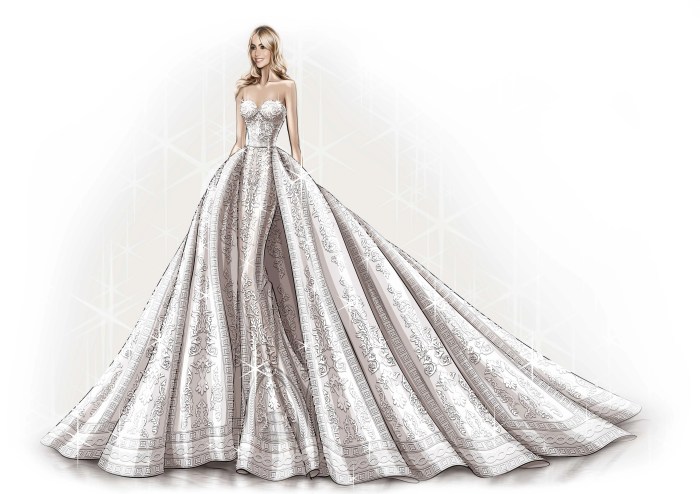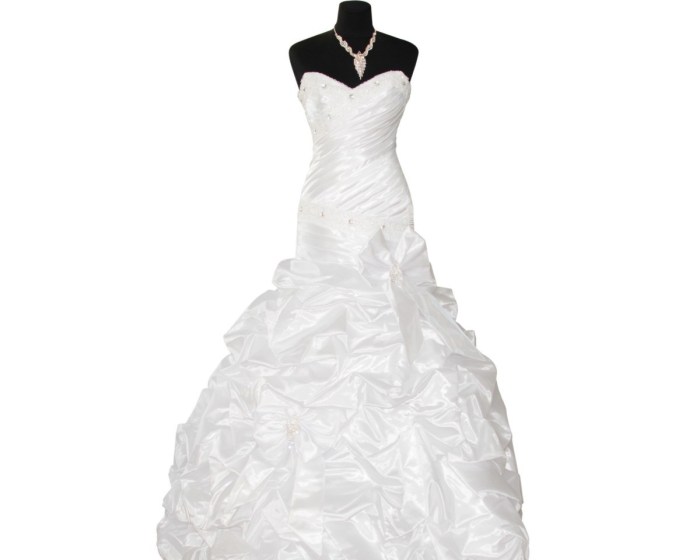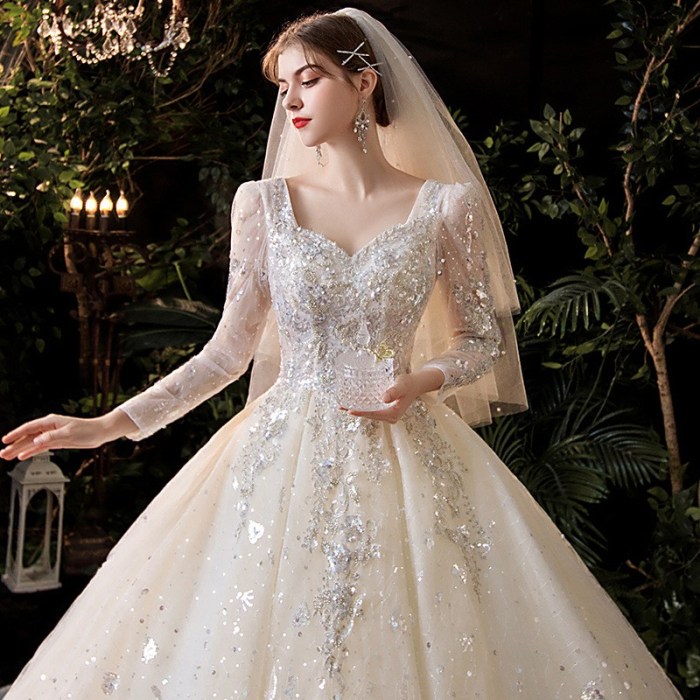Wedding Dress Styles: A Comprehensive Guide
Female dress for wedding – Choosing a wedding dress is a momentous occasion, a journey filled with excitement and perhaps a touch of overwhelm. This guide navigates you through the process, offering insights into various dress styles, body types, etiquette, budgeting, and styling tips to ensure you find the perfect gown for your special day.
Types of Wedding Dresses
A myriad of wedding dress styles cater to diverse tastes and body types. Understanding these styles is crucial in finding the perfect fit. Key silhouettes include A-line, ballgown, mermaid, sheath, and empire waist. Necklines range from sweetheart and V-neck to halter and off-the-shoulder, while sleeve options vary from sleeveless and short sleeves to long sleeves and even detachable sleeves.
Wedding Dress Fabrics
The fabric choice significantly impacts the dress’s drape, comfort, and overall aesthetic. Different fabrics are better suited for various seasons and venues.
| Fabric | Season | Venue Suitability | Description |
|---|---|---|---|
| Silk | Spring/Summer/Autumn | Indoor/Outdoor | Luxurious, lightweight, and drapes beautifully. Can be delicate. |
| Lace | Spring/Autumn | Indoor/Outdoor | Romantic, intricate, and can be used for various styles. Can be heavy depending on the design. |
| Tulle | Spring/Summer | Indoor/Outdoor | Lightweight, airy, and often used for full skirts. Can be easily damaged. |
| Satin | Spring/Autumn | Indoor/Outdoor | Smooth, lustrous, and creates a sleek silhouette. Can be prone to wrinkles. |
| Chiffon | Spring/Summer | Indoor/Outdoor | Lightweight, sheer, and flows gracefully. Can be delicate. |
Embellishments and Their Impact
Embellishments like lace, beading, and embroidery add depth and personality to a wedding dress. Lace adds a romantic touch, beading creates sparkle and glamour, while embroidery offers intricate detailing. The choice of embellishment depends on the overall style and the bride’s preference. Heavily embellished dresses are more formal, while simpler designs offer a more minimalist aesthetic.
Choosing a Dress Based on Body Type
The ideal wedding dress accentuates your best features. Different styles flatter various body shapes. Consider your body type—hourglass, pear, apple, or rectangle—when selecting a dress.
Dress Styles for Different Body Types
An hourglass figure is well-suited to A-line, mermaid, or fit-and-flare gowns that emphasize the waist. Pear shapes benefit from A-line or ballgown dresses that balance the hips. Apple shapes look stunning in empire waist or A-line dresses that draw attention upward. Rectangle shapes can experiment with A-line, ballgown, or mermaid styles to create curves.
Height and Proportions
Height and proportions influence dress selection. Taller brides can carry off more dramatic styles, while shorter brides might prefer less voluminous designs. Proportions also matter; consider whether you want to emphasize or de-emphasize certain features.
Visual Guide: Necklines and Waistlines
A sweetheart neckline accentuates the bust, while a V-neck elongates the torso. A high neckline creates a more modest look. An empire waistline emphasizes the bust and minimizes the lower body, while a natural waistline highlights the waist. A dropped waistline creates a flowing, romantic silhouette.
Wedding Dress Etiquette and Trends
While traditions offer a beautiful foundation, modern trends constantly refresh the wedding dress landscape. Understanding both provides a framework for your selection.
Traditional Wedding Dress Etiquette
Traditional wedding dress etiquette often suggests white or ivory for the dress, floor-length for formality, and a style appropriate for the venue and time of day. However, these are guidelines, not strict rules.
Current Wedding Dress Trends

Source: vogue.com
- Sustainable fabrics and ethical production
- Bohemian styles with lace and flowing fabrics
- Minimalist designs with clean lines and simple silhouettes
- Statement sleeves (puff sleeves, bishop sleeves)
- Colorful accents (belts, embroidery)
Modern Interpretations of Classic Styles
Classic styles like A-line and ballgown dresses are constantly reimagined with modern twists. Modern interpretations might incorporate unconventional necklines, sleeves, or fabrics, while maintaining the essence of the classic design.
Budget and Shopping Strategies: Female Dress For Wedding
Setting a realistic budget and employing smart shopping strategies are crucial for finding your dream dress without breaking the bank.
Wedding Dress Price Ranges
Wedding dress prices vary widely, from a few hundred dollars to tens of thousands. Factors influencing cost include fabric, embellishments, designer, and retailer markup.
Setting and Sticking to a Budget

Source: thrfun.com
Allocate a specific percentage of your wedding budget to the dress. Track your spending and avoid impulse purchases. Prioritize what’s most important to you in a dress.
Budget-Friendly Shopping Strategies
- Attend sample sales for significant discounts.
- Explore consignment shops for gently used dresses.
- Shop online retailers for broader selection and potential savings.
- Consider renting a dress instead of buying.
- Set a firm budget and stick to it.
Accessories and Styling
Accessories and styling complete the wedding day look, enhancing the dress and reflecting the bride’s personality and wedding theme.
The Role of Accessories
Veils, jewelry, and shoes play a vital role in creating the overall aesthetic. A cathedral-length veil adds drama, while a simple birdcage veil offers a vintage touch. Jewelry choices should complement the dress and the bride’s style.
Styling Options
A bohemian-style dress pairs well with flower crowns and flowing veils. A classic ballgown looks stunning with elegant jewelry and a simple updo. A minimalist sheath dress might be styled with statement earrings and modern heels.
Hypothetical Scenario: Styling a Specific Dress
Imagine a bride choosing a simple A-line dress with delicate lace detailing. To complete the look, she could wear a delicate pearl necklace, elegant drop earrings, ivory heels, and a simple, elbow-length veil. Her hair could be styled in a loose, romantic updo with soft curls framing her face.
Finding the Perfect Dress: The Process
Finding the perfect wedding dress involves careful planning, research, and professional guidance.
Steps Involved in Finding and Purchasing a Wedding Dress, Female dress for wedding
The process begins with browsing different styles and designers online and in bridal shops. Next, schedule appointments at bridal boutiques and try on various dresses. Once you find “the one,” order the dress and schedule fittings for alterations. Finally, collect the dress after final alterations and enjoy your special day.
Importance of Trying On Different Styles and Seeking Professional Advice

Source: susercontent.com
Trying on various styles helps you understand what flatters your body type and personal style. Bridal consultants provide expert advice, guiding you through the selection process.
Alterations and the Seamstress
Alterations ensure a perfect fit and enhance the dress’s overall look. A skilled seamstress makes necessary adjustments, ensuring the dress drapes beautifully and accentuates your figure.
Top FAQs
How far in advance should I start shopping for my wedding dress?
Ideally, begin looking 9-12 months before your wedding to allow ample time for alterations and potential delays.
What should I wear when trying on wedding dresses?
Wear nude-toned undergarments and comfortable shoes that resemble the height of your wedding shoes. Consider bringing a strapless bra if needed.
Can I bring a lot of people wedding dress shopping?
It’s best to limit your entourage to 2-3 trusted advisors to avoid overwhelming yourself and the bridal consultant.
What if I don’t like any of the dresses in the store?
Many bridal shops offer custom design services or can order dresses from other designers. Don’t be afraid to ask!
How much should I budget for alterations?
Typically, alterations cost between $300-$800, but this can vary greatly depending on the complexity of the alterations needed.
